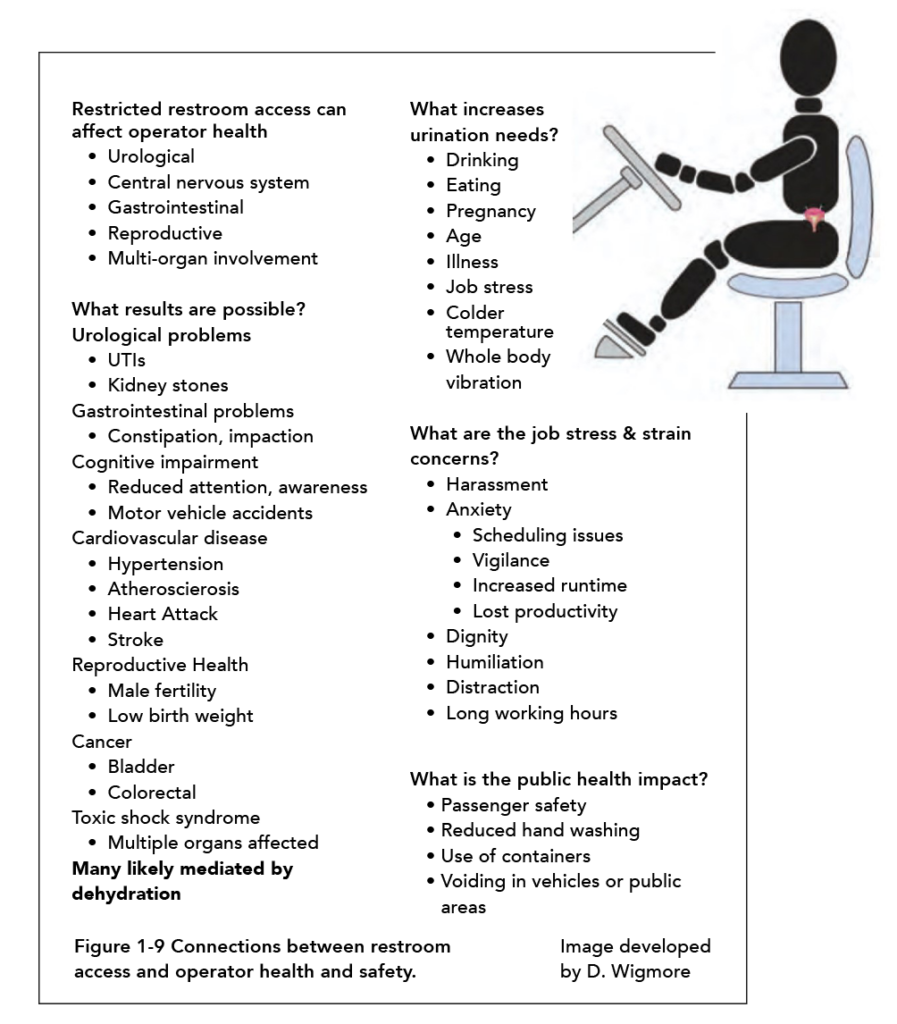Yet school bus drivers have no place to go
By Dorothy Wigmore
Imagine a job where you aren’t sure if or when you can use a bathroom. Where you have to line up with lots of others to use one washroom in a short time. Where studies show guys pee in a bottle at the side of the road, while women try to find appropriate devices to do the same.
Too often, that’s normal for bus drivers, according to a 2020 report (see Resources). The 60-some drivers at West Milford township’s school bus transportation department are one example of those dealing with bathroom access.
“We struggle with this every day,” says Dana Bekiers, chair of the West Milford Bus Drivers Association’s (WMBDA) newly formed health and safety committee. Bekiers is also WMBDA’s vice president. The district’s bus transportation yard trailer has only one bathroom.
“If you need to use the bathroom—which pretty much everybody usually does—you go to the trailer, and there’s a very long line to try to get into it,” Bekiers says. “Some people don’t have enough time. Depending on your route, you might have five minutes, some people might have 20, some might have 10.”
Drivers end up peeing at the side of the road, not drinking liquids, avoiding heart meds, and more. It’s particularly problematic for pregnant and menstruating women, or anyone with incontinence, irritable bowel syndrome, conditions requiring urgent access, or taking some medications. The short- and long-term health effects can be serious. (See graphic.)
Anxiety is another consequence, says Brianna O’Connor, another WMBDA member. She’s seen it at least once in her short tenure as a bus driver.
Without a contract clause or policies, drivers have few options.
“There are times during the winter when the bathroom pipes freeze,” Bekiers adds. “So we have to beg and plead to get into our supervisor’s office to use her bathroom. At times during COVID, they wouldn’t allow us to use her bathroom because they were concerned with the number of people coming through that building.”
Sometimes drivers can dash into a school. That’s difficult when parents are dropping off children at the same doors, or with limited time on packed runs. It’s impossible when schools aren’t open. Without keycard access, drivers depend on someone in the building letting them in.
At the local’s October meeting, drivers reported that once inside, they often are directed to student washrooms; with union support they’re now heading for an adult-only one, although it can take more time.
This is a long-time issue for transit operators around the world. That led the International Transport Federation (ITF) to issue the Transport Workers’ Sanitation Charter in 2019. They also supported the United Nations declaration of World Toilet Day on November 19.
The hazard also is a common public health issue, Lezlie Lowe says in her book, No Place to Go. How Public Toilets Fail Our Private Needs. She argues public bathroom access “is about cities, society, design, movement, and equity.”
The 2020 National Academies of Science (NAS) report “Improving the Safety, Health, and Productivity of Transit Operators Through Adequate Restroom Access,” agrees. The report makes clear that time to go is a key equity issue.
The Occupational Safety and Health Administration (OSHA) Sanitation Standard, adopted by New Jersey Public Employees Occupational Safety and Health (PEOSH), recognizes this. It is designed, “to ensure that workers do not suffer adverse health effects that can result if toilets are not sanitary and/or are not available when needed.”
That means employers must:
- Let workers leave their work location to use a restroom when needed.
- Prevent long lines with enough restrooms for the size of the workforce. (60 workers need four “water closets.” (Equitable gender access is a concern too.)
- Avoid imposing unreasonable restrictions on restroom use.
- Ensure restrictions (e.g., locking doors, requiring workers sign out a key) don’t cause extended delays.)
When the job site of a mobile worker—like school bus drivers—doesn’t have a bathroom, employers must provide “readily available transportation” that gives “prompt access (i.e., less than 10 minutes)” to those facilities somewhere nearby. That could be a restaurant, store or office building, where there’s an access agreement for bus drivers.
The NAS report provides a walking-time calculator, checklists, tools and solutions including union contract clauses. Their best practices make clear drivers need to be involved in planning, there’s not a one-size-fits-all solution, and it’s about the quality as well as quantity.
It also includes agreements to let bus drivers use the facilities in stores, restaurants, etc. That’s difficult in rural areas, Bekiers says. So the board of education office directly across the street from the West Milford bus yard is on their list for discussion with the district. As a result of the local’s meeting, members are ready to support drivers with that request and more.

From: National Academies of Science, Improving the safety, health, and productivity of transit operators through adequate restroom access.
Dorothy Wigmore is a consultant to the New Jersey Work Environment Council and a long-time health and safety specialist, trained in occupational hygiene, ergonomics, and “stress.” She has worked in Canada, the U.S. and Mozambique, focusing on prevention and worker participation to solve job-related hazards.
What can health and safety committees and locals do?
- Get stories: survey bus drivers and other “mobile” workers about bathroom access, asking about health effects and solutions too.
- Use the results, OSHA rules, the ITF charter and NAS report’s tools and best practices to develop gender-sensitive solutions that accommodate all members.
- Negotiate and enforce agreements about bathroom access for whenever members need it.
- Support efforts to ensure all members have easy bathroom access as needed.
Resources
International Transport Workers’ Federation (ITF)
“ITF Sanitation Charter,” 2019
Lezlie Lowe
No Place to Go: How Public Toilets Fail Our Private Needs
National Academies of Science
“Improving the Safety, Health, and Productivity of Transit Operators Through Adequate Restroom Access,” 2020
bit.ly/3FneLZg
Occupational Safety and Health Administration (OSHA)
“Restrooms and Sanitation Requirements”
osha.gov/SLTC/restrooms_sanitation.